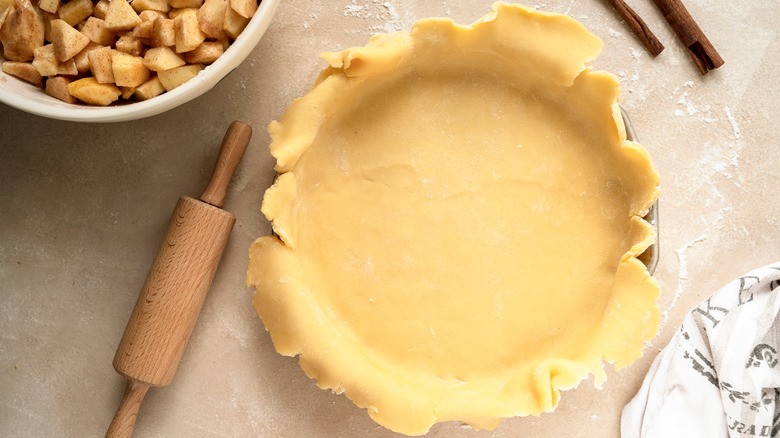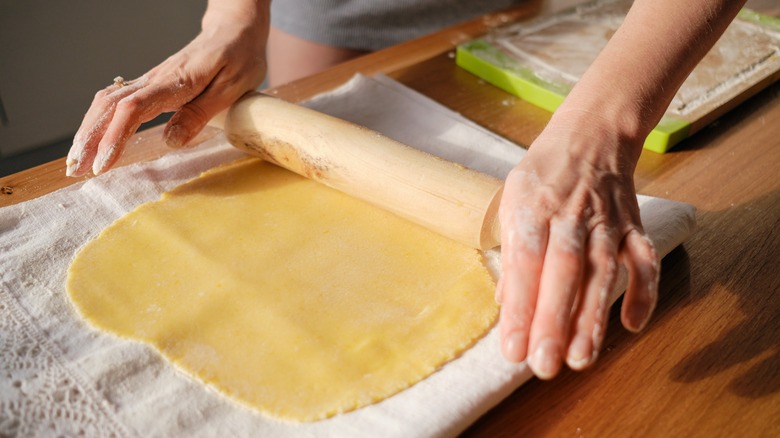Ina Garten's Genius Trick To Fit Pie Dough In The Pan Without Stretching
A homemade pie is the ultimate in comfort food. No matter what the filling, whether it's savory or sweet, it's often the buttery, flaky crust that makes you want to go back for another slice. But making pie dough from scratch can also be a daunting task for home cooks. It can easily be undercooked and soggy, or dry and brittle. And perhaps most stressful of all is the act of transferring the pie dough from the board to the pan and making sure it fits neatly before you even begin cooking it.
There's a risk that rolled pie dough can tear when moved into a pan, especially if it's flimsy and thin. And while it might be tempting to stretch it to fit, this isn't advisable, as stretching causes the dough to shrink when it's cooked. Luckily, Ina Garten has many great tips for baking any kind of pie. And her advice includes a top trick to help get the dough into place in the pan without any fuss, and with no stretching involved.
The Barefoot Contessa's technique simply involves folding the rolled dough into quarters, and then unfolding it once in the pan. It means it can then be gently pressed into place, without damaging or stretching the delicate dough in the process.
Ina Garten folds pie dough in quarters to lay it in the pan
Pie dough can be tricky to transfer from the board to the pie tin because of its fragile nature once it's been rolled. While keeping the board well-covered with flour while rolling certainly helps, the dough can still easily break, and the stretchy texture makes it tricky to handle. Before attempting to move her rolled dough to the pan for baking, Ina Garten first folds the circle in half, and then in half again, to make a quarter.
The thickness of the dough in its folded shape makes it much easier to pick up and move. The delicate dough can easily be unfolded once it's been placed in the pan with the point of the quarter in the center, and simply needs to be lightly pressed into the edges and up the sides of the pan. It can then be trimmed to fit, leaving a little extra around the edge of the pan in case of shrinkage in the oven; around half an inch to an inch of excess is ideal.
When it comes to what sort of pan is best to press the pie dough into, Garten only uses metal pie tins as they help the dough to cook evenly and become nicely browned all over. And enamel and metal tins also mean there's less chance of a soggy-bottomed result when the pie is baked.
How to handle pie dough to avoid baking disasters
One of the reasons you have to be careful with stretching dough is because it can shrink when cooked, leaving a pie that is not properly encased. The dough's stretchiness is caused by gluten strands developing as you handle it, which makes it more elastic, and more likely to spring back into place once it's stretched.
There are several ways to avoid this, including handling the pastry gently, not overworking it, and leaving it to rest in the fridge. Chilling the dough before rolling, as well as at other stages during the baking process, allows it to relax and makes it less sticky, so it's easier to handle and move, and also less likely to shrink when baked. Adding a little acid such as lemon juice can also help the gluten to relax, as well as keep the dough a nice color.
Of course, the easiest way to avoid baking disasters and end up with a perfectly formed pie is to buy a ready-made pie crust from the grocery store. Even culinary queen Ina Garten admits that while it's better to make your own, some of the store-bought ones can be pretty good. So if you're not a natural baker, there's no shame in having a little helping hand. Then all you have to worry about is what filling to choose, which — unlike the dough — shouldn't be too much of a stretch.



